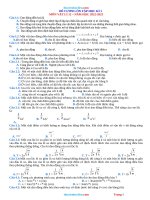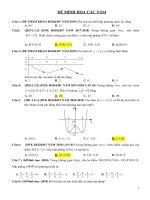UC Irvine Previously Published Works Title Confinement and heating of a deuterium tritium plasma Permalink
Bạn đang xem bản rút gọn của tài liệu. Xem và tải ngay bản đầy đủ của tài liệu tại đây (471.87 KB, 14 trang )
UC Irvine
UC Irvine Previously Published Works
Title
Deuterium and tritium experiments on TFTR
Permalink
/>
Journal
Plasma Physics and Controlled Fusion, 36(12 B)
ISSN
0741-3335
Authors
Strachan, JD
Adler, H
Barnes, CW
et al.
Publication Date
1994-12-01
DOI
10.1088/0741-3335/36/12B/001
License
4.0
Peer reviewed
eScholarship.org
Powered by the California Digital Library
University of California
zyxwvut
zyxwvutsrqpo
Plasma Phys. Control. Fusion 36 (1994) BSB15. Rinted in theUK
Deuterium and Tritium Experiments on TFTR
J.D. Strachan, H. Adler, Cris W. Barnes? S. Batha,z M.G. Bell, R.
Bell, M. Bitter, N.L. Bretz, R. Budny, C.E. Bush: M. Caorlin, Z.
Chang,4 D.S. Darrow, H.Duong,5 R. Durst? P.C. Efthimion, D.
Erns46 R Fisher: R.J. Fonck,$ E. Fredrickson, E. Grek, L.R.
Grisham, G. Hammett, R.J. Hawryluk, W. Heidbrink,’ H.W.
Herrmann, K.W. Hill, J. Hosea, H. Bsuan, A. Janos, D.L. Jassby,
F.C. Jobes, D.W. Johnson, L.C. Johitson, H. Kugel, N.T. Lamp B.
LeBlanc, F.M. Levinton? J. Machuzak$ D.K. Mansfield, E.
Mazzucato, R. Majeski, E. Marmar,6 J. McChesney,5 K.M.
McGuire, G. McKee? D.M. Meade, S.S. Medley, D.R Mikkelsen,
D. Mueller, M. Murakami? R. Nazikian, M. Osakabe,S D.K.
Owens, H. Park, S.F. Paul, M. Pelrov,9 C.K. Phillips, A.T. Ramsey,
M.H. Redi, D. R ~ b e r t sJ.
, ~Rogers, A.L. Roquemore, E. Rwkov,‘
SA. Sabbagh,lO M. Sasao$ G. SchiUing, J. Schivell, G.L. Schmidt,
S.D.Scott, C.H. Skinner, J.A. Snipes,6 J. Stevens, T. Stevensom,
B.C. Stratton, E. Synakowski, G. Taylor, J.L. Terry,6 A. von Halle,
S . von Goeler, J.E. Wilgen,3 J.R. Wilson, K.L. Wong, G.A.
Wurden,l M. Yamada, K.M. Young, M.C. Zarnstorff, and S.J.
Zweben
zyxw
zy
z
zyxw
zyxw
zyx
Princeton Plasma Physics Laboratory, P.O. Box 451, Princeton, NJ 08543
LOS AIamos National Laboratory, Los Alamos, NM
2Fusion Phybics and Technology, Torrance, CA
3Oak Ridge National Laboratory, Oak Ridge, TN
4University of Wisconsin, Madison, WI
SGeneral Atomics, San Diego, CA
6Massachusetts Institute of Technology, Cambridge, MA
7~niversityof California, Irvine, CA
gNational Institute for Fusion Science, Nagoya, Japan
9Ioffe Physical-Technical Institute, Russia
loColumbia University, New York, NY
Abstract. Three campaigns, prior to July 1994, attempted to increase
the fusion power in DT plasmas on the Tokamak Fusion Test Reactor
[TFTR]. The first campaign was dedicated to obtaining >5 MW of fusion
power while avoiding MHD events similar to the JET X-event. The
second was aimed at producing maximum fusion power irrespective of
proximity to MHD limits, and achieved 9 MW limited by a disruption.
The third campaign increased the energy confinement time using lithium
pellet conditioning while raising the ratio of alpha heating to ,beam
heating.
0741-3335/94/0oooO3+13$19.50 @ 1994 IOP Publishing Ltd
B3
zyxwvu
zyxwvut
zyxwvutsrq
zyxw
B4
J D Strachan et al
1. Introduction
zyx
zyx
zy
TFTR commenced tritium operation in November 1993 [1,2] and produced 182
plasmas containing some amount of tritium by July 1994. A major element of this
period was to determine the DT fusion power level which can be achieved in TFTR.
A fusion power output of 6.2 MW was attained in December 1993 and 9.2 MW in May
1994. Subsequently, similar plasmas have been used to study tritium isotope effects
[3] and expected alpha-particle driven instabilities. Analysis of those effects will be
reported in other papers at this conference and in future publications. The primary
purpose of this paper will be to describe the campaigns directed at raising the fusion
power and the relevant issues.
The challenge of maximizing fusion power production is simultaneously
addressing several important problems in tokamak research the plasma must have
good energy confimement, with high neutral beam power, and low impurity influx from
the limiter and walls. Comparative experiments between DT and DD are best
conducted away from stability limits to ensure that small changes in stability
boundaries due to isotope and other effects do not complicate the comparison.
Moreover, since the expected alpha particle heating and isotope effects are modest in
magnitude, high reproducibility of plasma conditions is required to allow the isotope
scaling and alpha heating to be identified separately. This was accomplished by
comparing performance in pure deuterium, pure tritium and 5050 DT plasmas. The
plasma performance must be predictable since the desired plasma conditions must be
obtained on the specific (and infrequent) plasmas in which tritium is used. Since a
separate goal is to attain the highest fusion power regardless of reproducibility, then
plasmas with the highest beam power, highest confinement, lowest impurity influx, and
best stability must also be obtained in DT.
The most striking feature of the campaign to raise the fusion power has been
that in the course of optimizing the energy confinement time through lithium
conditioning [4], the confmement rose so much that the overall performance of TFTR
is no longer confinement limited but is stability limited. That is, TFTR operating with
maximum beam power and the maximum achievable confinement time encounters high
p disruptions even at maximum plasma current and toroidal magnetic field.
2. Experimental Campaigns
zyx
zy
TFTR operated at R/a = 2.52d0.87m. 5.1T toroidal magnetic field with neuaal beam
heating in three different campaigns to produce DT fusion power (Fig. 1). The three
campaigns were:
2.1. December 1993 Campaign
In December 1993, Ip = 2.0 MA, and PB = 29 MW was used in an effort to obtain
greater than 5 MW of fusion power. The machine parameters were selected to avoid a
minor disruption which on TFTR would appear similar to the SET X-event [5].
zyxwv
zyx
zyx
z
zyxwvut
Deuterium and tritium experiments on TFTR
zyx
B5
Essentially, this required operating the experiment at less than full beam power (29.5
MW out of a potential 37 MW) and at less than the optimum energy confinement time.
The confmement time was kept low by not using lithium pellet conditioning. The result
was that 42 deuterium comparison plasmas were performed with only six having minor
disruptions while none of the trace tritium, 50:50 DT, or full tritium plasmas had a
minor disruption.
Fusion
Power
(MW)
3.0
1.0
zyxwv
zyxwv
Time (sec)
E m r e 1. Time evolution of the DT fusion power produced during the
three campaigns to increase the TFTR fusion power. In December
1993, the beam power was up to 29.5 MW and the duration was from
3.0 to 3.75 sec. In May 1994, the beam power was up to 32 MW and
the duration was from 3.5 to 4.25 sec. In June 1994, the beam power
was up to 21 MW and the duration was from 3.7 to 4.7 sec.
A consequence of this experiment was that an excellent set of DD to DT
comparison plasmas was obtained in which the key parameters known to affect energy
confinement and neutron emission in supershot plasmas were held constant, including
the beam power, the fraction of beam power in the co-direction, the plasma current, and
the degree of wall conditioning (as expressed empirically by the carbon influx at the
beginning of the beam injection). The parameters obtained in this campaign (Table 1)
consistently indicated that the DT plasmas have better performance than the DD
plasmas. An analysis of these differences is being reported elsewhere [3]. Of
considerable interest is that in TFTR, the fraction of the electron density due to alphas
is about one-half that of ITER. This motivatks campaigns to increase fusion power on
TFTR, and thus to make the beta-alpha more relevant to an ignited plasma.
zyxwvuts
2.2. May 1994 Campaign
The second campaign occurred in May 1994 using Ip = 2.5 MA, PB up to 33 MW, and
up to two lithium pellets (about 1 sec before neutral beam injection) to improve the
plasma confinement The plasma current was chosen as the maximum available (with
B6
zyxwvu
zyxwvu
zyxwvu
zyx
.ID Strachan et al
a reasonable flattop time) in order to maximize the Troyon j3 limit and achieve the
maximum energy content in the plasma. The intention was to apply the maximum
neutral beam power; however, minor and major disruptions occurred with about 33
MW of bcam power (11 out of 12 sources). Effectively, the plasma performance was
limited by the disruptive behavior at the highest injected beam powers.
The campaign in May 1994 was remarkable for the effect that the lithium pellet
conditioning had upon the energy confinement time during beam heating. The
previous best TFTR confinement time at 2.5 MA had been about 0.11 sec (at the time
of peak neutron emission) (Fig. 2) which was modestly above L-mode. At the
beginning of the campaign, even without lithium pellet injection, the confinement time
was about 0.15 sec. This increase is presently interpreted as a conditioning effect from
the preceding experiment which featured intensive lithium pellet conditioning. The
confmement time rose to about 0.2 sec as first one lithium pellet was added prior to
beam injection, then two lithium pellets, and fmally two lithium pellets as well as a 1.6
MA ohmic preconditioning plasma (with 4 Li pellets). With DT plasma operation and
1 or 2 Li pellets before the beam injection, the isotope effect brought the conhement
time up to 0.24 sec or nearly three times the L-mode confinement.
zyxwvuts
zyxw
zyxwvu
zy
I
0.15
I
I
I#
3.6
3.8
4.0
Time (sec)
Figure 2. Time evolution of the energy confimement time for 2.5 MA
beam heated ? m R plasmas. The range of L-mode energy confinement
is indicated in the shaded region and depends upon the beam power.
The bottom curve represents the best TFCR performance at 2.5 MA up
to July 1993. The next four curves represent the effect of lithium pellet
conditioning of DD plasmas as pan of the May 1994 campaign. The top
two curves represent the effect of lithium pellet conditioning of DT
plasmas. The beam injection began at 3.5 sec in all cases.
The May 1994 sequence of DD plasmas in Fig. 2 were all taken at 19.5 MW of
beam power and illustrate (Fig. 3) the pronounced effect that the lithium conditioning
had upon the density profile, and particle influxes during the beam injection. At about
zy
zyxz
zyxwv
zyxw
zyxwvu
zyxwv
Deuterium and tritium experiments on TFTR
B7
400 msec after the start of beam heating (3.9 sec in Fig. 3), the hydrogen influx and
carbon influxes were halved while the central density was about constant (or increased
by 10%); the density peakedness was increased by about 50%. and the energy
confinement time increased about 30%.
-76653 -76651
-
76650 .-.-76649
2
0.2
m
n
c
0
m
m
0.1
~-zyxwv
L
3
G
El
x
r
r
0
5
1
3.6
3.8
4.0
4.2
Time (Sec)
F i u r e 3. Time evolution of four plasmas each having 19.5 MW of beam
heating. 76649 had no lithium pellets. 76650 had one Li pellet about 1
sec before beam injection, 76651 had two Li pellets about 1 sec before
beam injection and 76653 had two Li pellets prior to beam injection and
was preceded by a four Li pellet ohmic @re-conditioning) shot. The
data are, energy confinement time, visible bremsstrahlung emission,
H a light-hydrogen flux, CII light-carbon influx, central electron
density, and density peakedness ne(o)/<ne>. The'beam injection began
at 3.5 sec.
The general observations are consistent with previous measurements of the effects of
lithium pellets [4] except that they seem more pronounced at the higher plasma current
(2.5 MA) of this campaign. Higher plasma current also correlates with higher pahcle
influxes from the walls, especially during ohmic heating. Qualitatively, the lithium
conditioning seems to be effective at reducing the higher particle influx at higher
plasma c m n t Historically, supershot performance in TFTR has deteriorated at higher
plasma currents. Initially (in 1986), supershots were most effective at low plasma
current (- 1.0 MA) and, over the years, conditioning improvements meant that
supershot behavior extended to higher plasma currents. The maximum current that can
sustain ZE > 1.8 Z&"de
has increased from 1.0MA in 1986 to 2.5 MA in 1994.
B8
zyxwvu
zyxwvu
zyxwv
zyxwvu
zyxwvutsr
zyxwvu
zyxw
zyxwv
J D S t r a c h et a1
2.3. June 1994 Campaign
-
The third campaign took place in June 1994 using ID = 2.1 MA,
20 MW and four
Li pellets injected at least 1 sec before neutral beam heating. In this campaign, the
plasma current was chosen as the maximum that allowed enough time for the four
lithium pellets to be injected. The beam power w'as reduced sufficiently to avoid
approaching p limits. As a consequence, approximately the same DT fusion power was
produced as in December 1993 but using about two-thirds of the beam heating power.
The peak energy confinement time achieved w s about 0.28 sec.
There are several significant features about the profiles (Fig. 4) produced at the
highest confinement times. Compared to the July 1993 plasma (Fig. 2), there are
significant reductions in De, Xe, and xi with associated increases in ne(o), Te(O), and
Ti(0). At the time of the highest confmement, the central Ti actually became flat at a
value of about 35 keV for d a e 0.25, and the ion energy balance became convection
dominated (Fig. 5). The initial impression is that the increases in TE due to Li pellet
conditioning afe accompanied by a broad, flat Ti(r) as the region dominated by
convective losses became broader. Similar observations have been made previously on
supershot behavior [6];however, the June 1994 plasmas seem to be a more extreme
example.
Minor Radius (m)
Ficure 4 The ne(+ Te(r), and Ti(r) profiles with the deduced De(r),
Xe(r), and xi(r) profiles. The solid line is the best TFTR DT
confinement time from the June 1994 campaign (2.1 MA, 20.5 MW
DT), the long dashed line is the July 1993 plasma (Fig. 2) (2.5 MA, 30.5
MW, DD), the short dashed line is the top DD data point in Fig. 2 from
the May 1994 campaign (2.5 MA, 19.5 MW, DD). The quoted
assumes there is no convection and all the ion losses are conduction.
zyx
zyxwvu
zyx
zyx
zyxwv
zyxw
zy
Deuterium and tritium experiments on TFTR
B9
3. Fusion Power Production
The fusion power can be calculated by the TRANSP code [7] for all nominally 50:50
DT plasmas including the plasma with the highest fusion power (Fig. 6). This means
that the neutron production agrees in magnitude with that expected for d(t,n)a fusion
reactions produced in a plasma with the measured temperature and density profiles.
For these TFTR plasmas, the beam-target reactions tend to dominate (Fig. 6) with
significant thermonuclear and beam-beam reactions. These ratios are typical for TFTR
supershot plasmas.
zyx
zyxwvu
:r/
,
inte rated Ion Loss s
"P
!
z 5
...
"!P
.
'\"\\\\\\\
5
2
a.o
Pbond+ p k n v
1
o.2
0.4
0.6
0.8
o.o
w
o.2 0.4 0.6 0.8
Minor Radius (m)
Figure 5. The radial dependence of the conduction and convection
terms in the energy balance near the time of peak energy confinement
time. The ratio of the total ion loss to the convective ion losses indicates
that the convective multiplier is in the range of 1.2 and is probably
within uncertainties of 3/2.
Empirically, the D(d,n) 3He fusion neutron emission, SDD from TFTR
supershots (with neutron components similar to Fig. 6) has scaled [Z] as
SDD =E2/&
where E is the total energy content in the plasma and Ip is the plasma current (Fig. 7 ) .
The DT data in which the fraction of tritium beam power 11% between 30%and 70% of
the total also follows a similar scaling relation with (Fig. 8)
B10
zyxwvut
zyxwvut
zyxwvu
zyxwv
zyxwv
J D Strachn et a1
zyxw
zyxwvu
TRANSP
total
Neutron
measured
8
Fusion
6
(MW)
Yield
4
2
beam-beam
0
3.5
3.6
3.7
38
3.9
Time bee)
Fieure 6. Time evolution of the DT fusion power from the highest yield
TFTR plasma with the TRANSP calculation of the expected DT fusion
power and its components.
zyxwv
The DD fusion neutron rate from the 1990 T F R data set
plotted against the empirical scaling relation E2/dIP
The variation in Ip is only between data at 1.8 + 2.1 MA and 2.5 MA (Fig. 9). The
scalings [Eq.(2)] of the DT plasmas is quite similar to the scaling of the DD @q. (l)]
plasmas indicating that optimization of the deuterium plasmas for DD neutron emission
is a valid indicator of expected DT neutron performance. Further, the strong
dependence upon plasma energycontent indicates that the relevant parameters for
zyxwvu
zyz
Deuterium and tritium experiments on TFTR
mole
B11
, , , I , , , , l I I J l l l l l / l ~ l l l l1 ~1 1 I "
~~
Dl
~
4 i ' 1 1 1 ' 1
'
'
zyxwvu
,
I
0.0
,
,
,
,
0.5
, , ,
,
1.0
,
,
I
I
1.5
z
.-
J
O
'
zyxw
,
EMPIRICAL F I T
zyxwv
,
, , , ,
,
2.0
2.5
, , , ,
t
3.0
X I O ~
Fieure 9. The DT fusion power production for the data in Fig. 8 plotted
against the empirical scaling relation EW~I,,.
B12
zyxwvu
zyxwv
zyxwvu
zyxwvuts
zyxwvu
zyxwvuts
J
D Strachan et a1
improving the DT fusion power are the product of the energy confinement time and the
applied neutral beam heating power. Plotting the 1990 and 1992 DD supershot data
(over 1,OOO plasmas) in T' E, PB space (Fig. 10) indicates that DD data tended to evenly
fill a space below 32 MW and 160 msec confinement time. The DT plasmas form
bands of fusion power along contours of constant plasma energy content irrespective of
whether that energy content is obtained at high applied beam power or high energy
confinement time.
.
The DT IIeUKOn production plotted as a function of the percentage of the beam
sources that are used in tritium (Fig. 11) has a broad maximum around 50%. The
plasmas with tritium-beams only have 40-60% of the DT neutron emission expected
from Eq. (2). The fact that they have any DT neutron emission is due to the deuterium
influx from the walls where a large reservoir has been established from DD plasmas.
Figure 11 indicates that there is little further benefit to operating slightly rich in tritium
beyond the effect of maximizing the plasma energy content.
zyx
zy
0.30
h
c
0
m
6
c
42
5
E4
E
a
6
zyxwvutsrq
0.25
zyxwvutsr
0.20
0.15
0.10
0
5
10
15
20
25
Neutral Beam Power @fW)
30
35
Fieure 10. The energy confinement time (at time of peak neutron
emission) plotted against the applied neutral beam power. The X-points
are the DD data from 1990 arid 1992 (over 1,000 plasmas). The
remaining symbols represent DT plasmas having different fusion power
3.5 - 5.0 MW is open circles, 5.0 - 6.5 MW is open squares, 6.5 - 8.0
MW is the solid squares, and 9.2 MW is the sm. The lines are constant
energy content.
zyx
zyxwvutsrq
zyxwvutsr
zyxwvutsrqp
zyxw
zyx
zyx
zyxwvutsrq
Deuterium and tritium experiments on TFTR
I
N
0
R 1.0
n
A
L
I
z
6
D
F
u
N
P
0
W
E
1
-
B
0
O
€
F
P
x
0
X X
o
E
s 0.9-
I
0
I
eS,"
O
B13
m
R
-
0
O
R
0.0
zyxwvutsrq
I
4. Summary
TFJX has achieved fusion power up to 9 MW limited by disruptive MHD activity.
These results are due, in part, to the dramatic effect of lithium pellet conditioning and
the tritium isotope effect upon energy confinement time. In order to further increase
the peak DT fusion power and to extend the duration of high DT fusion power for
alpha studies, it is proposed to increase the toroidal magnetic field from 5.2 T to 6 T.
Empirically, it has been observed that the maximum DD neutron emission scales with
the fourth power of the toroidal magnetic field (Fig. 12). This is possible from a
scaling law like Eq. (1) where the maximum attainable energy content is determined by
a Troyon-like energy limit
and if q i s about constant, then
SDD"==B
4
.
B14
zyxwvut
zyxwv
zyxwvut
zyxwvut
J D Strachan et al
zyxwvu
The fact that q = constant may be a con~sequenceof the high central pressures in TFTR
snpershots suggesting that the q = 1 surface is important, or that the q on axis is
important (i.e., central current density). The empirical data in Fig. 12 indicates that a
potential 1.7 times increase of the DT fusion pwwer may occur by raising the toroidal
magnetic field from 5.2 T to 6 T.
zyx
40
50
60 70 80 90
Toroidal field coil current (kA)
Fieure 12, The DD neutron emission plotted as a function of the c m n t
in the TFTR toroidal magnetic field coils.
Acknowledgment
This work was supported by the U.S. Department of Energy Contract No. DE-ACO276-CHO-3073.
Parameter
CenEal density ne(0)
Effective charge
Units
1019m-3
~
(Gff)
Electron temperature
Te(0)
Ion temperatnre Ti(0)
Energy replacement
Time (Q)
Central alpha density
~
keV
keV
seconds
1019,-3
JETDT TFTRDD TFTRD-T
3.6
1.7
1.6
2.4
2.4.
2.3
~
~
9.9
9.2
18.8
25.6
0.9
0.0029
0.145
---
10.8
33.0
0.176
0.013
Tablel. Parameters for DD and DT Comparison P l u m s
..
,
zyxw
zyx
zyz
Deuterium and tritium experiments on TFTR
References
B15
zyxwvu
Hawryluk R J, et al., Phys. Rev. Lett. 72 (1994) 3530.
Strachan J D, et al., Phys. Rev. Lett. 72 (1194) 3526.
Scott S D, Ernst D R, Murakami M, Adler H, Barnes Cris W, et al., "Isotopic
scaling of transport in deuterium-tritium plasmas", presented at Workshop on
Transport in Fusion Plasmas, Goteborg, Sweden, June 1994. Submitted to
Physica Scripta.
I41 Snipes J, et al., Proc. of European Con$ on PL Phys. and Conrr, Fusion perfin,
1991) P w t m p. 141.
The JET Team, Nucl. Fusion 32,187 (1992).
Zamstorff M C, Bell M G, Bitter M, Bush C, Fonck R J, et al., "Convective Heat
Transport in TFTR Supershots", Proceedings of the 15th European Conference
on Controlled Fusion and Plasma Physics, Dubrovnik, 1988, Vol. 1, 1988,
(European Physical Sociery, Petit-Lancy, Switzerland), p. 95-98.
zyxwvutsrq
I71 Budny R, et al., Nucl. Fusion 3Z, 429 (1992).
[81
Strachan J D, et al, NucL Fusion 33.991 (1993).





